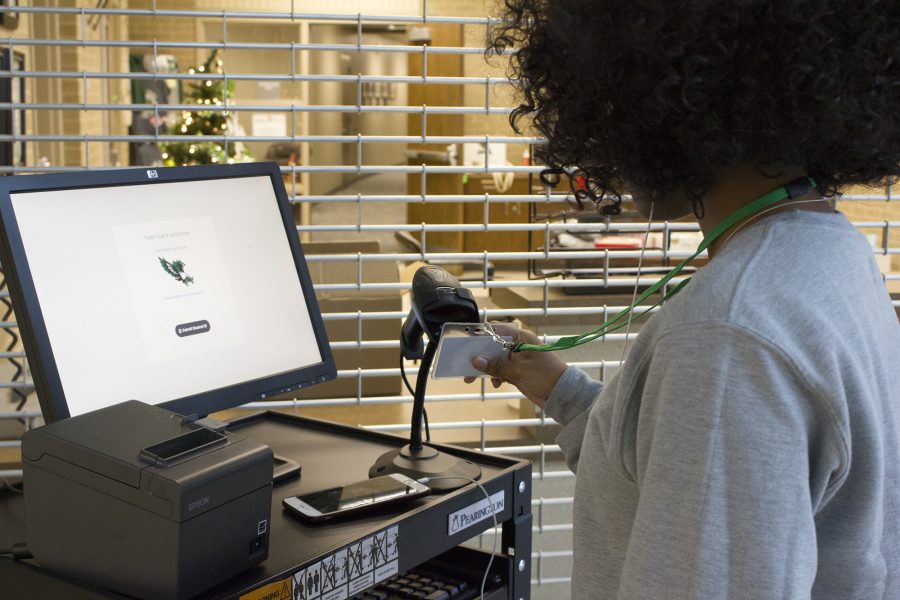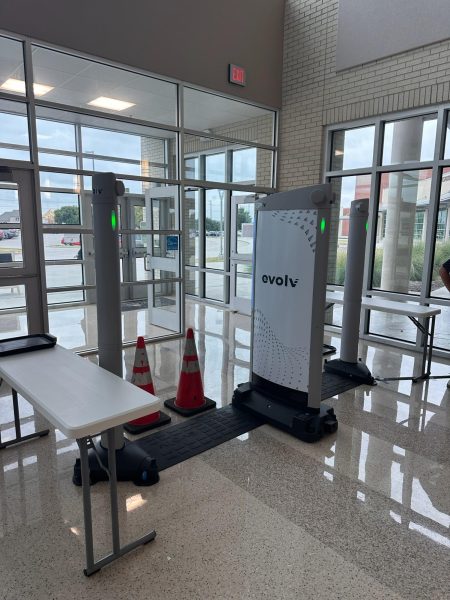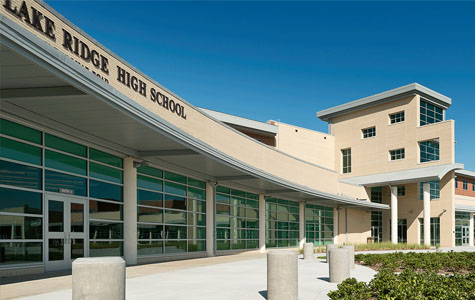Student Conductor: To Be Or Not To Be Late
A student at the I.D. station
Everyone has the same 24 hours in a day. For students, exactly seven hours and thirty minutes of the day is spent at school, give or take the few who, through a combination of traffic, failures on their own part, and perhaps a questionable tardy system aren’t arriving to class on time.
This year, Lake Ridge received an influx of new students. This, combined with the location of the school and the difficulties associated with entering the tardies in by hand as was procedure in previous years, students who were tardy at the beginning of the year would find themselves in long lines at the attendance office that made what would’ve been a two minute delay to class a forty minute waiting game. Kourtney Gates, Academic Associate Principal said she was not happy with how long the lines were, but administration quickly found a solution to their problem.
“We were trying to get a handle on tardies and our main focus was the loss of instruction time for students waiting in line in the morning to get a pass to class. We were looking for a quicker way to get kids in class and a more efficient way so that students and parents were immediately informed about how many tardies they had and what the consequence would be,” Gates said.
Student Conductor is the tardy software Lake Ridge administrators determined to use for the 2018-2019 school year. To reach this decision administrators visited the campus of two other schools to analyze the efficiency of the student conductor program. The final decision to switch over was made by Principal Brandon Johnson, but was based on information collected by Assistant and Associate Principals alike.
The student conductor software is attached to 5 computers placed around the school and requires you to scan your ID. Your entry is then logged, timestamped, and a pass to class is printed out for you. The system also tracks your tardies over a given period of time, whether it be six weeks or semester, and is capable of emailing you your consequence if you have too many. The goal is to give students a sense of urgency about their commitment to school.
“When you aren’t in class you’re losing instructional time. Not being in class can impact grades. I wish every kid would just get to class on time and that would work but tardy policy is district and so the district feels that having a consequence assigned will encourage students to get to class,” said Gates.
Student Conductor has been in the school district before, but is only just now being implemented at Lake Ridge. Because of the system, instead of having every tardy student go to the attendance office and wait in a long line that delayed their entry to class in some cases by over 40 minutes, the 5 tardy machines are “getting students to class 80% faster” according to Michael Sypert, Assistant Principal.
Despite all the issues administrators aimed to fix, something that still seems to be a major issue among students is traffic, which some have often blamed for their inability to make it to school before 7:25 AM.
“We have had this discussion about traffic but one of the things we focus on here is what we call life-ready skills and so just like the next step for our seniors, whether it will be school or a job, you will have to factor in traffic in adjusting the time it takes you to get ready to get there. We have had the discussion but we also can’t change the start time of school,” said Gates.
However, administrators can only do so much on behalf of students. This year, Lake Ridge has 2,657 students. The average number of tardies right now is 93, based on data collected from student conductor with the majority of tardies coming from students arriving late in the morning.
“If you have 96 tardies throughout the course of the day with that many students on campus, it’s not a huge number. We have a very small percentage of students who aren’t getting here on time. So when you have 90% of your students who are able to get here on time, it kinda takes the traffic issue and gives you a different look at it,” Sypert said.
So where do students stand when it comes to their involvement in their own attendance? The traffic issue or excuse seems to be overused in the eyes of administrators but is still a point of contention for students. Brandon Gentry, senior, has had issues with traffic in past years and aims to avoid that this year.
“I used to be super tardy my freshman and sophomore year when I was getting rides from my sister and she didn’t wake up in time to beat traffic. My junior year I got my car so I was pretty much on time all the time. This year, I’ve only been tardy once but I’ve got to wake up extremely early just to avoid traffic to make that happen,” Gentry said.
Though Gentry seems to have had little involvement with the new tardy system, the thing that encourages him to get to school on time now is his desire to avoid the system at all costs.
“Tardies used to be a process of just being given a note and going on about your day but now you’ve got to deal with this system and notes, where instead of signing your name down you have to log it into something. I think the new system is a good idea but it’s being executed in a bad way and isn’t effective,” Gentry said.
He also acknowledges his tardies are most often his own fault. However, he does thinks the districts focus on what they call “life-ready skills” has not had any real effect on him and, due to his view of what life after school will be, he can’t take it seriously.
“It’s a punishment for being late when in the real world being late doesn’t stop you from doing anything physically, it stops you from doing things socially. Your boss or colleagues may feel annoyed by you being late but it won’t stop you from doing your work. Here at school it does,” Gentry said.
Conversely, Terren Blackwell, junior, has seen an increase in his tardies, not only in the morning but throughout the day, and has a strong dislike for the new system.
”We used to be able to just be able to be marked tardy when we got to class but at least you still got to be in there. Now you have to wait in a long line and miss class or be sent out of class for a tardy pass if you don’t bring one in initially,” said Blackwell.
Blackwell remembers a day where, upon arriving to school late in the morning, he found himself in a line that filled the length of the whole front hallway and didn’t make it to class until it was time for second period. If he could change the system, he would take things back to how they were.
“I liked it better when they just marked you in class or wrote out a quick pass at the office. It’s extremely frustrating to come in at 7:26 and not see any type of school until 9:00. You can’t have long car lines and long lines to get to class. One has to go,” said Blackwell.
Blackwell believes some of his tardies are not his fault and also offer him little experience with how the “real world” is supposed to be.
”Sometimes I don’t wake up on time but I also don’t have any control over how fast my parents drive or when they wake up. Being marked tardy because of how long I sat in a line outside just seems unfair to me. On my job I would take being late more serious because it would be a more professional setting. School doesn’t motivate me to give it that same attention,” Blackwell said.
At the end of the day, there isn’t much administrators can do about traffic outside. The disparity seems to be that, between students and faculty, each one needs to know what they are responsible for. While the faculty can make adjustments to the system to benefit students, students also have a responsibility to uphold values that will put them in a position to be successful in the established policy.












